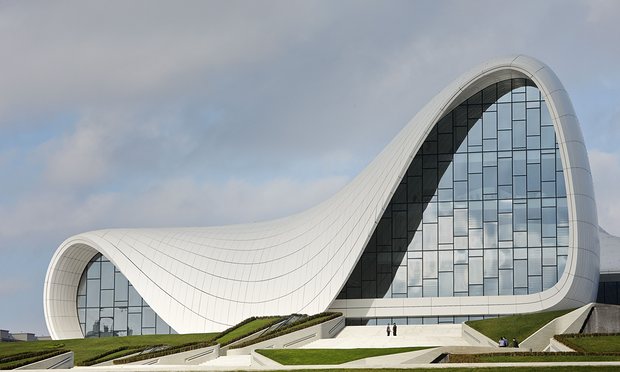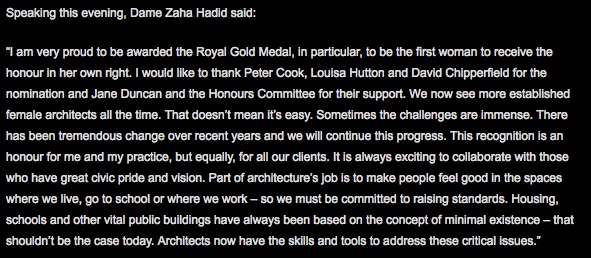It is April 1st, still, and yet this is not an April Fool joke – sadly, tragically, one of the world’s most influential architects, Zaha Hadid, has died at age 65. And yes, she was also a woman. She was also British, phlegmatic, born in Iraq, educated at the AA in London, and reputedly an absolute tyrant to work for, but she was, undoubtedly, a most brilliant architect. And now she has gone. Sixty-five is too young – I had hoped that we would have many more years of her architectural gymnastics to enjoy.

The local press of course hasn’t picked up on it yet, while of course it is all over Facebook etc – but the Guardian newspaper has a good, short article here, where columnist Oliver Wainwright calls her the “unparalleled queen of the curve and conjuror of sinuous, billowing forms”. Other writers have penned a longer obituary which you can find here, which tells us that she died of a heart attack in a Miami hospital, following a bout of bronchitis.

I’ll leave it to Peter Cook, her mentor at the AA, to have the last word:
“In our current culture of ticking every box, surely Zaha Hadid succeeds, since, to quote the royal gold medal criteria, she is someone who ‘has made a significant contribution to the theory or practice of architecture … for a substantial body of work rather than for work which is currently fashionable’.
“For three decades now she has ventured where few would dare … Such self confidence is easily accepted in film-makers and football managers, but causes some architects to feel uncomfortable. Maybe they’re secretly jealous of her unquestionable talent. Let’s face it, we might have awarded the medal to a worthy comfortable character. We didn’t. We awarded it to Zaha: larger than life, bold as brass and certainly on the case.â€
Actually, it definitely seems more fitting that Zaha herself has the last word, from her occasion just a month or so ago, when she got the RIBA Gold Medal:





Frank Gehry says (via the Architectural Record):
“When asked to reflect on architect Zaha Hadid’s legacy, Frank Gehry had four words: “Great architect, great person.â€
Hadid, whose death Thursday morning at the age of 65 rocked the world of architecture, had a long professional relationship with Gehry, beginning when he worked with Vitra in the early 1990s to select a designer for its firehouse on its campus in Weil am Rein, Germany.
“She took a Russian constructivist theme to three dimensions in a way that I hadn’t seen, a way that was enticing,†Gehry recalled when reached by phone in Los Angeles Thursday. “It was beautiful.â€
Gehry served on the Pritzker Architecture Prize jury in 2004 the year Hadid was awarded the honor—the first woman to receive the accolade independent of a partner. “There was nobody even close,†Gehry said.
“From the beginning I thought of her as one of the guys,†Gehry, himself a Pritzker laureate, said. “She never did this in front of me, but I wouldn’t have been surprised if she would whip out a cigar and smoke it.â€
While Hadid was often portrayed in the media as difficult and formidable, Gehry remembers a fun-loving personality.
He recalled a day at one Venice Architecture Biennale: “Zaha was surrounded by 30 or 40 people with cameras clicking all over. So I walked by quietly so I wouldn’t bother her. And I just got past and I heard this voice say, ‘Hey Frank, come on over here!’ And she dragged me in front of them and said, ‘This is Frank Gehry, my friend.’ In the middle of her press thing! She was that gal.â€
The New Yorker magazine’s John Seabrook comments:
“I have never known anyone whose reputation provoked more terror yet whose actual presence was more fun than Dame Zaha Hadid’s. There have always been difficult personalities in architecture. The profession itself seems calculated to make one egotistical and intractable. But it always amazed me that Hadid had somehow attracted a singular reputation for being difficult to deal with. Compared with other prominent architects, no one was more down to earth, more exuberantly real, than her.
On the occasions that we spent together when I was working on my 2009 Profile and then, more recently, at a 2015 New Yorker Festival event, I was struck anew by the warmth and humanity that this supposed harridan radiated. The scary starchitect of popular imagination was just that, a fiction. Why was it necessary? Why did every second article attach “diva†to her name? Isn’t every architect a diva?
Truly, it was because Hadid was a woman who had dared to enter a man’s world, and took no shit from anybody, though plenty was offered. She had to be twice as smart and three times as tough as her male counterparts in order to get anything built. And even then she struggled for years to realize her projects, and was forced to endure cruel and humiliating referendums on such thwarted projects as the Cardiff Bay Opera House, or the ongoing Olympic-stadium debacle in Tokyo, in which the government blocked Hadid’s competition-winning design from going forward after protests from prominent Japanese architects.”
http://www.newyorker.com/culture/culture-desk/postscript-zaha-hadid-1950-2016/
Rem Koolhaas on Zaha, in this transcript from his days as her tutor at the Architectural Association in the mid 1970s:
“Zaha’s performance during the fourth and fifth years was like that of a rocket that took off slowly to describe a constantly accelerating trajectory. Now she is a PLANET in her own inimitable orbit. That status has its own rewards and difficulties: due to the flamboyance and intensity of her work, it will be impossible [for her] to have a conventional career. She owes it to her talent to refine and develop over the next few years.”
Tribute to Dame Zaha Hadid from Norman Foster 31st March, 2016, from Shanghai.
I am devastated by the news of the loss of Zaha Hadid and cannot comprehend the enormity of her passing away. I became very close to her as a friend and colleague in parallel with my deep respect for her as an architect of immense stature and global significance.
She was one of the very few architects as friends who was invited to my 80th Birthday Party in London last year. By a strange coincidence some days ago I received an email from one of her clients – someone she had designed a home for. With great pride he sent me about twenty pairs of images. Each pair showed the visualisation that Zaha presented and the reality as finally built. It was a beautiful juxtaposition of what Zaha promised and what she delivered. I was so looking forward to sharing with her these intimate insights. Tragically that will never happen.
I think it was Zaha’s triumph to go beyond the beautiful graphic visions of her sculptural approach to architecture into reality that so upset some of her critics. She was an individual of great courage, conviction and tenacity. It is rare to find these qualities tied to a free creative spirit. That is why her loss is so profound and her example so inspirational. And, besides, she was my dear friend.
A few days late, but better late than ever, Fairfax catches up with the news:
http://www.stuff.co.nz/life-style/home-property/78561191/late-architect-zaha-hadid-leaves-phenomenal-architectural-legacy
“It is not just the design and architecture world that is mourning the death of London-based architect Zaha Hadid, 65, who was hailed as the most important woman architect of our time.
The beneficiaries of her work – the students who walk through her inspiring corridors of academia, the visitors to the galleries who pass in awe beneath her soaring domes, the concertgoers who marvel at her theatres, and the workers who get to enjoy her astonishing office buildings are also mourning the loss of one of the world’s greatest architects.”
The good old FT has a decent obituary up on Zaha:
…but bugger – its behind a firewall. Damn. Here’s a snippet:
““If I was a man,†Dame Zaha Hadid told me, “do you think I would be called a diva? No — they would just talk about the architecture.â€
She was, of course, architecture’s greatest diva. But she was also perhaps its most original, inventive and visionary designer. Hadid was always inevitably billed as the “greatest female architect†but very few men — if any — could match the distinctiveness of her style, the sculptural brilliance of her architecture or the sheer force of her character.
Very few designers invent an entirely new architecture. Hadid did.”